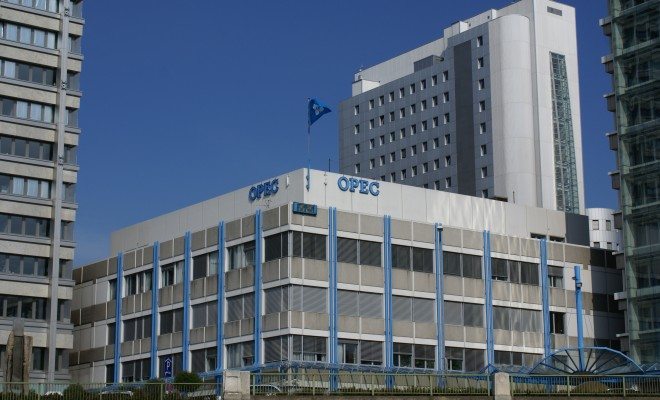 Image courtesy of [alex.ch via Flickr]
Image courtesy of [alex.ch via Flickr]
Business & Economics
An Over-Supply of Underpriced Oil: Explaining the New Energy Crisis
The Organization of Petroleum Exporting Countries (OPEC) recently met in Vienna to discuss an official output quota. By the end of the meeting, however, the member countries did not agree on a quota and oil production remains near record levels. While this may not seem like breaking news, the group’s decision will have major ramifications far beyond its members. That is because this decision comes at a time when the price of oil is falling to lows not seen since the Great Recession. It is also coming at a time when a massive over-supply of oil exists in the market.
Read on to learn more about OPEC’s decision based on its past and future plans. Why does the group refuse to turn off the pumps when the wealth of supply seems to be hurting the bottom line?
History of OPEC
OPEC was founded in 1960 by its five original members: Iran, Iraq, Kuwait, Saudi Arabia, and Venezuela. Since then, nine members joined the group: Qatar, Indonesia, Libya, the United Arab Emirates, Algeria, Nigeria, Ecuador, Angola, and Gabon. The organization’s stated objective is to “co-ordinate and unify petroleum policies among Member Countries, in order to secure fair and stable prices for petroleum producers,” but the group has historically faced criticism for trying to control the price of oil for political and economic reasons. OPEC’s members meet regularly to agree upon oil production quotas, which in turn influence the price of oil internationally.
While many have a negative perception of OPEC, the organization’s roots were generally good-intentioned. The group formed shortly after many oil producing countries emerged after colonial empires were split up. Its inception, in part, explains OPEC’s desire to set a price as a means to control and benefit from its member nations’ natural wealth.
Criticism of the group peaked in the 1970s after two high-profile events: namely, its 1973 embargo on oil exports to the United States and the fallout from the 1979 Iranian Revolution. Oil prices eventually dropped dramatically in the 1980s only stabilizing in the 1990s. This happened because of a variety of factors including a burgeoning interest in the environmental impact of oil. Oil experienced another boom in the late 90s through to the mid-2000s. However, it once again experienced a sharp decrease as a result of the 2008 Global Recession.
Following the recession, oil prices started rising, reaching a peak in 2014. Since the middle of last year, the price of oil has dropped precipitously, causing a flurry of responses from countries that are dependent on the oil industry for survival. The video below provides a detailed history of OPEC:
What is OPEC up to?
The most recent drop in oil prices brings us to where we are now. On December 7, oil prices hit their lowest levels in seven years. In fact, since June 2014 when the price of oil peaked at $108 per barrel, the price of oil has lost two-thirds of its value. The underlying driver behind the recent price drop is primarily an over-supply of oil. One explanation for the drop is the American shale boom, which significantly increased oil production in the United States. Another is the decision by OPEC not to cut its production but to keep it at near record output levels.
If a good’s supply increases but demand stays the same or decreases then its price will go down. The overall goal then is to find the equilibrium somewhere in the middle, where sellers can offer their goods at a price they feel is reasonable and at which consumers are willing to pay. OPEC’s recent decision to continue to keep production levels high has contributed to the massive drop in the global price of oil. Doing so challenges OPEC members’ ability to cover their expenses and profit off of high prices.
The question then is why? The simple answer is market share and scale of production. Saudi Arabia, a major player in OPEC, is willing to take a loss on oil in the short-term in an effort to disadvantage its competitors. The relatively long period of high oil prices that occurred over the past few years made new, more expensive means of getting oil profitable. This led to a rise in oil extraction methods like deep-water drilling and shale oil production (including fracking) in the United States. This method of getting oil is notably difficult and expensive, but with high oil prices, companies were able to spend more to extract oil because they could still turn a profit. Now that the price of oil has fallen dramatically, such efforts are becoming too expensive and shale oil production has gone down. If the price of oil stays low for a long period of time this could significantly hurt the shale industry helping OPEC countries like Saudi Arabia in the long run. This would play into the Saudis’ long-term goal of gaining back its market share, once the playing field has been thinned. But while a decrease in U.S. production has already started to happen oil prices have not yet gone back up, putting oil producers in a tricky place. The accompanying video gives a look at OPEC’s actions:
In the meantime, Saudi Arabia and the rest of OPEC also have to contend with other established nations in the oil industry, namely Russia. While the Saudis have started to make their way into traditional Russian oil markets, Russia has fired back by temporarily becoming the largest supplier to Asia, an area typically dominated by OPEC. The struggle between these two has also added to the oversupply in the market, as neither wants to concede its customers.
Further Trouble Ahead
OPEC’s strategy is decidedly risky for reasons beyond temporary loss in revenue due to lower prices. First, there’s the return of Iran to the forefront of the global oil market. Iran is currently under sanctions and its oil exports are limited to roughly 1.1 million barrels a day–about half of its peak production in 2012. However, international sanctions on Iran are now going away in light of the Iran nuclear deal, and the country plans to produce 500,000 more barrels a day with the ultimate goal of reclaiming its market share–as Saudi Arabia and Russia are doing–no matter the cost.
Second, demand for oil could also start contracting next year, as some analysts think demand could shrink by up to as much as one-third. While drivers typically do more driving when oil is cheaper, the economic slowdown in Asia, particularly in China, threatens to cause an even larger over-supply of oil on the world market. But foreseeing changes in demand can be particularly difficult. Other analysts argue that the recent changes in China could lead to even greater demand for oil as the country shifts to a more consumer-driven economy.
Ramifications
OPEC
The concerns listed are less true for Saudi Arabia, OPEC’s de facto leader, which the IMF estimates can last about five years with oil prices at current levels before it needs to make significant changes to its budget. The Middle Eastern countries in the worst shape, however, are Iran and Iraq. While Iran’s refining costs are not particularly high relative to other countries, its economy suffered a significant blow from international sanctions. Its neighbor, Iraq, is in even worse shape, facing not only mounting debt but also the specter of ISIS operating and controlling a large swath of its territory. Forgone revenue from unusually low prices could start to hurt oil-exporting countries without large cash reserves.
The consequences of low oil prices could be just as bad, if not worse, for members of OPEC outside of the Middle East. Countries such as Ecuador, Venezuela, Nigeria, and Algeria are extremely reliant on oil for government revenue, often for the majority of their budgets. Low prices have already sparked fear of unrest in areas such as Nigeria and Venezuela, which like Saudi Arabia use oil revenue to maintain social and economic stability. In Ecuador, these fears have already been realized–thousands have gone to the streets to protest government cost-cutting as a result of the falling price.
Russia
Outside of OPEC, perhaps no country is feeling the effects of the declining value of oil as much as Russia. Like many of the OPEC nations, it is very dependent on oil for income. In fact, oil and gas make up roughly two-thirds of Russian exports and half of all government revenue. With prices dropping so low, the nation has subsequently felt the effects–Russia’s economy will contract by about 3.8 percent this year and is expected to shrink further in 2016.
United States
Unlike Russia and the OPEC nations, the United States is not particularly dependent on oil production for government revenue, but the drop in prices will have some impact. If OPEC and Saudi Arabia hope to keep prices low to eliminate American competitors, evidence suggests that may be working. The number of oil rigs in the United States has fallen slightly and domestic production has decreased. In fact, for some U.S. states that rely on the oil industry for jobs and revenue, like Texas, Alaska, North Dakota, Oklahoma, and Louisiana, falling prices can pose a notable economic challenge.
However, the price plunge is certainly not all bad news for Americans. The average price of gasoline per gallon is now considerably lower than this time last year. Additionally, according to the United States Energy Information Administration, the average household is also likely to save $750 on gas this year. These savings are especially helpful for lower-income people who spend more of their income on gas and heating. Similar savings will likely occur in many European countries as well. The following video looks at some of the effects of low oil prices:
Conclusion
The members of OPEC, particularly Saudi Arabia, are taking a notable gamble with their decision to keep oil production high despite low prices. If oil-exporters reduce their production they could lose their market share, but if oil prices remain low they could face fiscal crises and possibly unrest. Yet the decision could pay off in the long run as more expensive forms of oil production slow down and prices go back up.
While OPEC is notably pumping too much oil, an issue that will likely become worse when Iran increases its exports, nearly all oil producing countries find themselves in a race to the bottom. Oil producing countries are already experiencing the consequences of low prices, but that will likely worsen if the status-quo continues. Meanwhile, the United States and most oil-importing Western nations stand to benefit.
Resources
CNN: OPEC is at War and it’s Sending Shockwaves Around the World
CNN: Oil prices dive below $37 to Lowest Level in Seven Years
Library of Economics and Liberty: Supply
Bloomberg View: Saudi Arabia’s Oil War with Russia
The Wall Street Journal: Global Demand Growth for Oil May Fall by a Third in 2016
CNN Money: Saudi Arabia to Run Out of Money in Less Than 5 Years
New York Times: From Venezuela to Iraq to Russia, Oil Price Drops Raise Fears of Unrest
Reuters: Russian Government Sees 2015 GDP Down 3 percent, More Optimistic Than Other Forecasts
Guardian: OPEC Bid to Kill off U.S. Shale Sends Oil Price Down to 2009 Low
New York Times: Oil Prices What’s Behind the Drop? Simple Economics
The Christian Science Monitor: Can Canada’s Oil Sands Survive Low Oil Prices?
U.S. News and World Report: Energy Stock Winners and Losers When U.S. Oil Exports Go Global








Comments